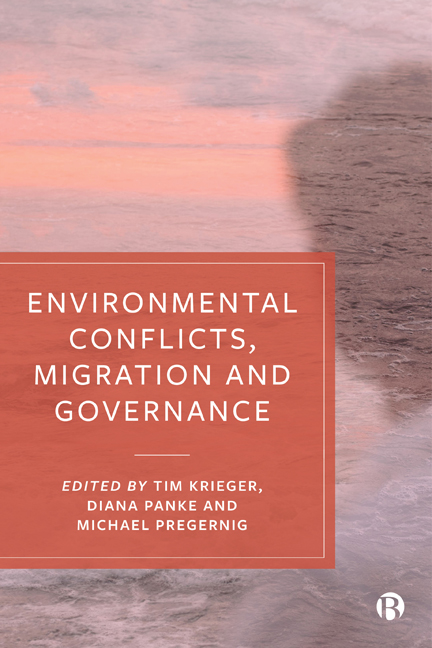Book contents
- Frontmatter
- Contents
- List of Figures and Tables
- List of Acronyms
- Notes on Contributors
- Acknowledgements
- 1 Environmental and Resource-Related Conflicts, Migration and Governance
- 2 Renewable Resource Scarcity, Conflicts and Migration
- 3 Extractive Resources, Conflicts and Migration
- 4 Climate Change, Conflicts and Migration
- 5 The Individual Level: Selection Effects
- 6 The Individual Level: Sorting Effects
- 7 Migration Governance at the State Level: Policy Developments and Effects
- 8 Environmental Migration Governance at the Regional Level
- 9 Migration Governance at the Global Level: Intergovernmental Organizations and Environmental Change-Induced Migration
- 10 The Link between Forced Migration and Conflict
- 11 Conflict-Prone Minerals, Forced Migration and Norm Dynamics in the Kimberley Process and ICGLR
- 12 On the Nexus Between Environmental Conflict, Migration and Governance: Concluding Remarks
- Index
8 - Environmental Migration Governance at the Regional Level
- Frontmatter
- Contents
- List of Figures and Tables
- List of Acronyms
- Notes on Contributors
- Acknowledgements
- 1 Environmental and Resource-Related Conflicts, Migration and Governance
- 2 Renewable Resource Scarcity, Conflicts and Migration
- 3 Extractive Resources, Conflicts and Migration
- 4 Climate Change, Conflicts and Migration
- 5 The Individual Level: Selection Effects
- 6 The Individual Level: Sorting Effects
- 7 Migration Governance at the State Level: Policy Developments and Effects
- 8 Environmental Migration Governance at the Regional Level
- 9 Migration Governance at the Global Level: Intergovernmental Organizations and Environmental Change-Induced Migration
- 10 The Link between Forced Migration and Conflict
- 11 Conflict-Prone Minerals, Forced Migration and Norm Dynamics in the Kimberley Process and ICGLR
- 12 On the Nexus Between Environmental Conflict, Migration and Governance: Concluding Remarks
- Index
Summary
Introduction
The diverse impacts of environmental changes on human beings are increasingly being documented. The effects of such changes can be difficult to isolate from the multiple factors that may increase voluntary or forced movement at the domestic or international level (OHCHR, 2018 ). These movements can be related to severe weather events, as regularly reported by the Internal Displacement Monitoring Centre (IDMC), which can result in temporary and/or internal displacement (IDMC, 2018). Indeed, the impacts of sudden-onset events on internal displacements are constantly increasing; on average, 21.7 million people were internally displaced each year in the period 2008– 16 by weather-related events (IDMC, 2017: 32), while by the end of 2017, 18.8 million people had been displaced by disasters in almost 135 regions (IDMC, 2018: 6). Also, slow-onset processes can lead to temporary mobility and then be followed by permanent mobility if the conditions do not improve. The World Bank recently issued the first report to offer projections of internal climate migration over large areas, with a particular focus on Sub-Saharan Africa, South Asia and Latin America, produced by combining socioeconomic and climate data (Rigaud et al, 2018; UNHRC, 2018).
While the majority of displacements in the context of climate change are internal, increasing numbers of people may be forced to move across borders (see Chapter 5). In particular, the exposure to slow-onset events, such as sea-level rise or desertification, can contribute to crossborder migration – although it is quite difficult to estimate the number of people involved. The recent report issued by the United Nations Human Rights Council (UNHRC) called attention to four regions (South Asia, Pacific Island States, the Sahel and Central America) where the risks posed by slow-onset events are progressively affecting vulnerable populations and mobility appears as a ‘a common response to changing conditions’ (UNHRC, 2018, para 7).
Central America is frequently subject to sudden-onset events like hurricanes, tropical storms and floods. On the other hand, the so-called Dry Corridor of the region, which includes Guatemala, Honduras, Nicaragua, El Salvador and Panama, is prone to droughts, but extreme weather events, like cyclones, are also increasing.
- Type
- Chapter
- Information
- Environmental Conflicts, Migration and Governance , pp. 137 - 156Publisher: Bristol University PressPrint publication year: 2020



